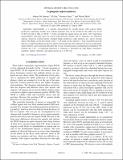| dc.contributor.author | De Simone, Andrea | |
| dc.contributor.author | Fan, JiJi | |
| dc.contributor.author | Sanz, Veronica | |
| dc.contributor.author | Skiba, Witold | |
| dc.date.accessioned | 2010-02-12T18:13:26Z | |
| dc.date.available | 2010-02-12T18:13:26Z | |
| dc.date.issued | 2009-08 | |
| dc.date.submitted | 2009-04 | |
| dc.identifier.issn | 1550-2368 | |
| dc.identifier.issn | 1550-7998 | |
| dc.identifier.uri | http://hdl.handle.net/1721.1/51749 | |
| dc.description.abstract | Leptogenic supersymmetry is a scenario characterized by cascade decays with copious lepton production. Leptogenic models have striking signatures that can be probed by the LHC even in the 10 TeV run with as little as 200 pb(-1) of data, provided the squark masses are about 1 TeV. Leptogenic supersymmetry spectrum arises in several well-motivated models and its signatures are long-lived sleptons, numerous isolated leptons, abundant Higgs production, rather energetic jets, and no missing energy. The Higgs can be discovered in the h→bb̅ mode via the 4 leptons+4 jets channel because the leptons accompanying Higgs production suppress the background. The superparticle masses in leptogenic supersymmetry can be measured efficiently due to lack of missing energy and high lepton multiplicity. We estimate that 1 fb(-1) of integrated luminosity is sufficient to determine the light Higgs, neutralinos, charginos, slepton, sneutrino, and squark masses in a 14 TeV run. | en |
| dc.language.iso | en_US | |
| dc.publisher | American Physical Society | en |
| dc.relation.isversionof | http://dx.doi.org/10.1103/PhysRevD.80.035010 | en |
| dc.rights | Article is made available in accordance with the publisher's policy and may be subject to US copyright law. Please refer to the publisher's site for terms of use. | en |
| dc.source | APS | en |
| dc.title | Leptogenic supersymmetry | en |
| dc.type | Article | en |
| dc.identifier.citation | De Simone, Andrea et al. “Leptogenic supersymmetry.” Physical Review D 80.3 (2009): 035010. © 2009 The American Physical Society. | en |
| dc.contributor.department | Massachusetts Institute of Technology. Center for Theoretical Physics | en_US |
| dc.contributor.department | Massachusetts Institute of Technology. Department of Physics | en_US |
| dc.contributor.approver | De Simone, Andrea | |
| dc.contributor.mitauthor | De Simone, Andrea | |
| dc.relation.journal | Physical Review D | en |
| dc.eprint.version | Final published version | en |
| dc.type.uri | http://purl.org/eprint/type/JournalArticle | en |
| eprint.status | http://purl.org/eprint/status/PeerReviewed | en |
| dspace.orderedauthors | De Simone, Andrea; Fan, JiJi; Sanz, Veronica; Skiba, Witold | en |
| mit.license | PUBLISHER_POLICY | en |
| mit.metadata.status | Complete | |
